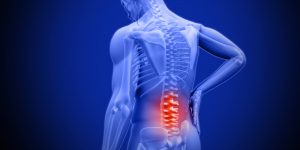
Introduction
At some point in our lives most of us will suffer from some sort of back pain but what does that pain mean? muscle sprain, slipped discs, herniated discs, disc bulges, are all common buzz words we hear when referring to back pain. The lumbar spine, or low back, is a remarkably well-engineered structure of interconnecting bones, joints, nerves, ligaments, and muscles all working together to provide support, strength, and flexibility. However, this complex structure also leaves the low back susceptible to injury and pain. To help understand this complex topic this article presents a model for understanding symptoms and physical findings to come to a precise diagnosis. Once an accurate diagnosis of the cause of the lower back pain is attained, treatment options can be selected based on today’s best medical practices.
What Can Go Wrong?
The low back supports the weight of the upper body and provides mobility for everyday motions such as bending and twisting. Muscles in the low back are responsible for flexing and rotating the hips while walking, as well as supporting the spinal column. Nerves in the low back supply sensation and power the muscles in the pelvis, legs, and feet.
Most acute low back pain results from injury to the muscles, ligaments, joints, or discs. The body also reacts to injury by mobilising an inflammatory healing response. While inflammation sounds minor, it can cause severe pain.
There is a significant overlap of nerve supply to many of the discs, muscles, ligaments, and other spinal structures, and it can be difficult for the brain to accurately sense which is the cause of the pain. For example, a degenerated or torn lumbar disc can feel the same as a pulled muscle – both creating inflammation and painful muscle spasm in the same area. Muscles and ligaments heal rapidly, while a torn disc may or may not. The time course of pain helps determine the cause.
Symptoms
Low back pain can incorporate a wide variety of symptoms. It can be mild and merely annoying or it can be severe and debilitating. Low back pain may start suddenly, or it could start slowly—possibly coming and going—and gradually get worse over time.
Depending on the underlying cause of the pain, symptoms can be experienced in a variety of ways. For example:
• Pain that is dull or achy, contained to the low back
• Stinging, burning pain that moves from the low back to the backs of the thighs, sometimes into the lower legs or feet; can include numbness or tingling (sciatica)
• Muscle spasms and tightness in the low back, pelvis, and hips
• Pain that worsens after prolonged sitting or standing
• Difficulty standing up straight, walking, or going from standing to sitting

In addition, symptoms of lower back pain are usually described by type of onset and duration:
• Acute pain. This type of pain typically comes on suddenly and lasts for a few days or weeks, and is considered a normal response of the body to injury or tissue damage. The pain gradually subsides as the body heals.
• Subacute low back pain. Lasting between 6 weeks and 3 months, this type of pain is usually mechanical in nature (such as a muscle strain or joint pain) but is prolonged. At this point, a medical workup may be considered, and is advisable if the pain is severe and limits one’s ability to participate in activities of daily living, sleeping, and working.
• Chronic back pain. Usually defined as lower back pain that lasts over 3 months, this type of pain is usually severe, does not respond to initial treatments, and requires a thorough medical workup to determine the exact source of the pain.
Identifying the symptoms and getting a diagnosis that pinpoints the underlying cause of the pain is the first step in obtaining effective pain relief.
Specifically identifying and describing symptoms can help lead to a more accurate diagnosis and effective treatment plan. Low back pain is typically characterised by a combination of the following symptoms:
Dull, aching pain. Pain that remains within the low back (axial pain) is usually described as dull and aching rather than burning, stinging, or sharp. This kind of pain can be accompanied by mild or severe muscle spasms, limited mobility, and aches in the hips and pelvis.
Pain that travels to the buttocks, legs, and feet. Sometimes low back pain includes a sharp, stinging, tingling or numb sensation that moves down the thighs and into the low legs and feet, also called sciatica. Sciatica is caused by irritation of the sciatic nerve, and is usually only felt on one side of the body.
Pain that is worse after prolonged sitting. Sitting puts pressure on the discs, causing low back pain to worsen after sitting for long periods of time. Walking and stretching can alleviate low back pain quickly, but returning to a sitting position may cause symptoms to return.
Pain that feels better when changing positions. Depending on the underlying cause of pain, some positions will be more comfortable than others. For example, with spinal stenosis walking normally may be difficult and painful, but leaning forward onto something, such as a shopping cart, may reduce pain. How symptoms change with shifting positions can help identify the source of pain.
Pain that is worse after waking up and better after moving around. Many who experience low back pain report symptoms that are worse first thing in the morning. After getting up and moving around, however, symptoms are relieved. Pain in the morning is due to stiffness caused by long periods of rest, decreased blood flow with sleep, and possibly the quality of mattress and pillows used.
Of course, there are other ways people experience low back pain. Low back pain varies on an individual level, and many factors influence the pain experience, including mental and emotional health, financial stress, or exercise and activity level.
Types of Lower Back Pain
There are many ways to categorise low back pain – two common types include:
• Mechanical pain. By far the most common cause of lower back pain, mechanical pain (axial pain) is pain primarily from the muscles, ligaments, joints (facet joints, sacroiliac joints), or bones in and around the spine. This type of pain tends to be localized to the lower back, buttocks, and sometimes the top of the legs. It is usually influenced by loading the spine and may feel different based on motion (forward/backward/twisting), activity, standing, sitting, or resting.
• Radicular pain. This type of pain can occur if a spinal nerve root becomes impinged or inflamed. Radicular pain may follow a nerve root pattern or dermatome down into the buttock and/or leg. Its specific sensation is sharp, electric, burning-type pain and can be associated with numbness or weakness (sciatica). It is typically felt on only one side of the body.

There are many additional sources of pain, including claudication pain (from stenosis) myelopathic pain, neuropathic pain, deformity, tumors, infections, pain from inflammatory conditions (such as rheumatoid arthritis or ankylosing spondylitis), and pain that originates from another part of the body and presents in the lower back (such as kidney stones, or ulcerative colitis).
It is also possible for low back pain to develop with no definitive cause. When this happens, the primary focus is on treating the symptoms (rather than the cause of the symptoms) and the patient’s overall health.
For subacute and chronic lower back pain, a thorough diagnosis is important to lay the foundation for appropriate treatment and rehabilitation. Lower back pain treatment reduces the likelihood of recurrent back pain flare-ups and helps prevent the development of chronic lower back pain.
Most commonly, mechanical issues and soft-tissue injuries are the cause of low back pain. These injuries can include damage to the intervertebral discs, compression of nerve roots, and improper movement of the spinal joints.
The single most common cause of lower back pain is a torn or pulled muscle and/or ligament.
Muscle Strain and Ligament Sprain
A low back sprain or strain can happen suddenly, or can develop slowly over time from repetitive movements.
• Strains occur when a muscle is stretched too far and tears, damaging the muscle itself.
• Sprains happen when over-stretching and tearing affects ligaments, which connect the bones together.
For practical purposes, it does not matter whether the muscle or ligament is damaged, as the symptoms and treatment are the same.
Common causes of sprain and strain include:
• Lifting a heavy object, or twisting the spine while lifting
• Sudden movements that place too much stress on the low back, such as a fall
• Poor posture over time
• Sports injuries, especially in sports that involve twisting or large forces of impact
While sprains and strains do not sound serious and do not typically cause long-lasting pain, the acute pain can be quite severe.
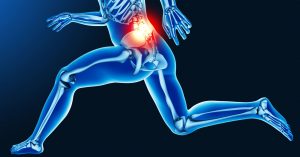
Causes of Chronic Lower Back Pain
Pain is considered chronic once it lasts for more than three months and exceeds the body’s natural healing process. Chronic pain in the low back often involves a disc problem, a joint problem, and/or an irritated nerve root. Common causes include:
Lumbar herniated disc. The jelly-like center of a lumbar disc can break through the tough outer layer and irritate a nearby nerve root. The herniated portion of the disc is full of proteins that cause inflammation when they reach a nerve root, and inflammation as well as nerve compression cause nerve root pain. The disc wall is also richly supplied by nerve fibers, and a tear through the wall can cause severe pain.
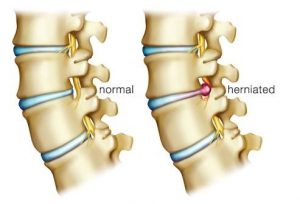
Herniated disc
Degenerative disc disease. At birth, intervertebral discs are full of water and at their healthiest. As people age over time, discs lose hydration and wear down. As the disc loses hydration, it cannot resist forces as well, and transfers force to the disc wall that may develop tears and cause pain or weakening that can lead to a herniation. The disc can also collapse and contribute to stenosis.
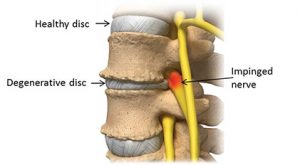
Degenerative disc disease
Facet joint dysfunction. There are two facet joints behind each disc at each motion segment in the lumbar spine. These joints have cartilage between the bones and are surrounded by a capsular ligament, which is richly innervated by nerves. These joints can be painful by themselves, or in conjunction with disc pain.
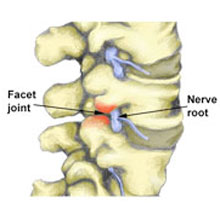
Facet joint dysfunction
Sacroiliac joint dysfunction. The sacroiliac joint connects the sacrum at the bottom of the spine to each side of the pelvis. It is a strong, low-motion joint that primarily absorbs shock and tension between the upper body and the lower body. The sacroiliac joint can become painful if it becomes inflamed (sacroilitis) or if there is too much or too little motion of the joint.
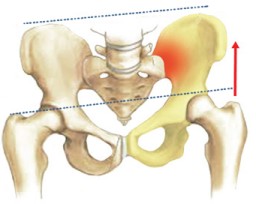
Sacroiliac joint dysfunction
Spinal stenosis. This condition causes pain through narrowing of the spinal canal where the nerve roots are located. The narrowing can be central, forminal, or both, and can be at a single level or multiple levels in the lower back.

Spinal stenosis
Spondylolisthesis. This condition occurs when one vertebra slips over the adjacent one. There are 5 types of spondylolisthesis but the most common are secondary to a defect or fracture of the pars (between the facet joints) or mechanical instability of the facet joints (degenerative). The pain can be caused by instability (back) or compression of the nerves (leg).

Spondylolisthesis
Osteoarthritis. This condition results from wear and tear of the disc and facet joints. It causes pain, inflammation, instability, and stenosis to a variable degree, and can occur at a single level or multiple levels of the lower spine. Spinal osteoarthritis is associated with aging and is slowly progressive. It is also referred to as spondylosis or degenerative joint disease.
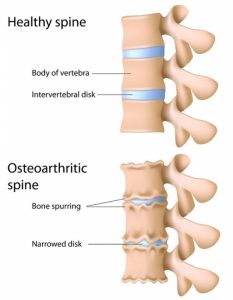
Osteoarthritis
Deformity. Curvature of the spine can include scoliosis, lordosis or kyphosis. The deformity may be associated with lower back pain if it leads to the breakdown of the discs, facet joints, sacroiliac joints or stenosis.

Deformity
Trauma. Acute fractures or dislocations of the spine can lead to pain. Lower back pain that develops after a trauma, such as a motor vehicle accident or a fall, should be medically evaluated.

Spinal dislocation
Compression fracture. A fracture that occurs in the cylindrical vertebra, in which the bone essentially caves in on itself, can cause sudden pain. This type of fracture is most common due to weak bones, such as from osteoporosis, and is more common in older people.
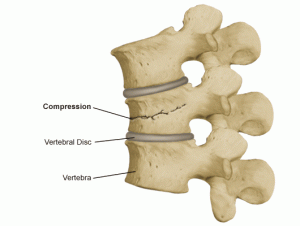
Compression fracture
It is important to note that the presence of one or more of these conditions does not necessarily mean that is the cause of pain. For example, osteoarthritis or degenerative disc disease could appear on an imaging study but the person may not report pain.
Low Back Pain Symptoms by Location
The body’s largest vertebrae are found in the lumbar spine, supporting most of the weight of the upper body. These vertebrae are highly susceptible to degeneration and injury, and an injury at one spinal level can cause a specific set of symptoms:
L3-L4. The L3-L4 nerve root is likely to cause shooting pain in the front of the thigh, possibly including numbness or tingling. Pain or neurological symptoms may radiate to the front of the knee, shin, and foot as well, though it is less common.
L4-L5. Pain from the L4-L5 segment typically manifests as sciatic pain in the back of the thigh, and possibly pain that reaches the calves, combined with axial low back pain.
L5-S1. Where the base of the spine connects to the sacrum there are a couple of joints that provide support and flexibility. One is the lumbosacral joint, which allows the hips to swing side to side, and the other is the sacroiliac joint, which has limited mobility and mainly absorbs shock from the upper body to the low body.
Pain from the L5-S1 segment is generally caused by problems with these joints or from a compressed nerve root. Issues with the L5-S1 segment commonly cause sciatica.
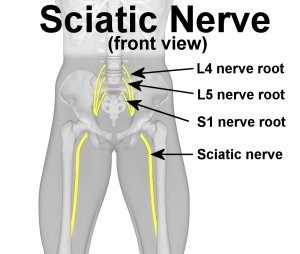
Different nerve roots are irritated depending on the structures in the back that are injured, and being able to point to the specific areas of radicular pain can help more precisely diagnose the source of low back pain.
Symptoms That Require Immediate Attention
Sometimes low back pain can signal a serious underlying medical condition. People who experience any of the following symptoms are advised to seek immediate care.
• Loss of bladder and bowel control
• Recent weight loss not due to lifestyle changes, such as diet and exercise
• Fever and chills
• Severe, unrelenting pain in the abdomen
Non Surgical Treatments
Many patients low back pain report relief from alternative treatments. Common options include:
Manual manipulation. A chiropractor or other healthcare provider makes physical adjustments to the spine with the goals of improving mobility and reducing stiffness, discomfort, or pain. Hand thrusts of varying speed and force are applied to adjust the spinal structures. Manual manipulation has been found to relieve low back pain in some people.

Spinal manipulation
Acupuncture. Based in ancient Chinese medicine, acupuncture stimulates points on the body thought to correct the body’s “qi,” or life force. It is believed that proper qi decreases pain and discomfort in the body. During a session, thin needles are placed in the skin for about an hour. Acupuncture has been shown to provide significant pain relief for some people.
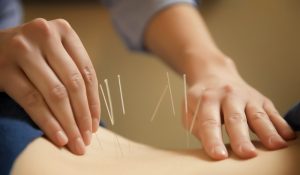
Acupuncture
Massage therapy. Applied to the low back, massage therapy can relieve the muscle spasms that usually contribute to low back pain. Massage also increases blood flow to the low back, which speeds up healing by bringing nutrients and oxygen to damaged muscles.

Massage
The above is not a comprehensive list; there are many more treatment choices available, including newer and less invasive surgical options. Surgery may be considered if for severe lower back pain that does not get better after a 6 to12-week course of nonsurgical treatments. It is almost always the patient’s decision to have back surgery, and only in rare situations is immediate surgery performed for low back pain.
Exercises for Low Back Pain
Physical therapy is usually part of a low back pain management regimen. Types of exercises used to rehabilitate the spine include:
Stretching. Almost everyone can benefit from stretching muscles in the low back, buttocks, hips, and legs (especially the hamstring muscles). These muscles support the weight of the upper body. The more mobile these muscles are the more the back can move without injury. It is typically advised to start small—stretch for 20 to 30 seconds and stop a stretch if it causes pain.
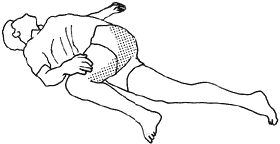
Lower back stretch
Strengthening exercises. Strengthening the abdominal, hip, and gluteus muscles that support the spine, also called the core muscles, can help relieve low back pain. Two common programs are the McKenzie method and Dynamic Lumbar Stabilisation.

Lower back strengthening
• The McKenzie Method extends the spine through building core muscle strength, reducing pain caused by compressed spinal structures such as a herniated disc caused by a compressed disc space.
• Dynamic Lumber Stabilisation strengthens back muscles to maintain a patient’s “neutral spine,” or the posture that feels most comfortable.
Low-impact aerobics. Low-impact aerobic exercise increases the flow of blood and supports healing from an injury without jarring the spine. Low-impact aerobics can include using stationary bikes, elliptical or step machines, walking, and water therapy. People with low back pain who regularly do aerobic exercise report fewer recurring pain episodes and are more likely to stay active and functional when pain flares.
Any exercise that elevates heart rate for a sustained period of time benefits the body. Regular physical activity is important for maintaining the range of motion and flexibility of a healthy spine. When spinal structures go unused for too long, stiffness and discomfort can worsen.




About The Author: Jade Parsons
More posts by Jade Parsons